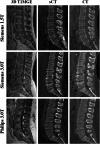Evaluation of MRI-based synthetic CT for lumbar degenerative disease: a comparison with CT
- PMID: 40596109
- PMCID: PMC12219671
- DOI: 10.1038/s41598-025-05399-x
Evaluation of MRI-based synthetic CT for lumbar degenerative disease: a comparison with CT
Abstract
Patients with lumbar degenerative disease typically undergo preoperative MRI combined with CT scans, but this approach introduces additional ionizing radiation and examination costs. To compare the effectiveness of MRI-based synthetic CT (sCT) in displaying lumbar degenerative changes, using CT as the gold standard. This prospective study was conducted between June 2021 and September 2023. Adult patients suspected of lumbar degenerative disease were enrolled and underwent both lumbar MRI and CT scans on the same day. The MRI images were processed using a deep learning-based image synthesis method (BoneMRI) to generate sCT images. Two radiologists independently assessed and measured the display and length of osteophytes, the presence of annular calcifications, and the CT values (HU) of L1 vertebrae on both sCT and CT images. The consistency between CT and sCT in terms of imaging results was evaluated using equivalence statistical tests. The display performance of sCT images generated from MRI scans by different manufacturers and field strengths was also compared. A total of 105 participants were included (54 males and 51 females, aged 19-95 years). sCT demonstrated statistical equivalence to CT in displaying osteophytes and annular calcifications but showed poorer performance in detecting osteoporosis. The display effectiveness of sCT images synthesized from MRI scans obtained using different imaging equipment was consistent. sCT demonstrated comparable effectiveness to CT in geometric measurements of lumbar degenerative changes. However, sCT cannot independently detect osteoporosis. When combined with conventional MRI's soft tissue information, sCT offers a promising possibility for radiation-free diagnosis and preoperative planning.
Keywords: Computed tomography; Lumbar degenerative disease; Magnetic resonance imaging; Synthetic CT.
© 2025. The Author(s).
Conflict of interest statement
Declarations. Competing interests: The authors declare no competing interests. Ethics approval: This prospective observational study was approved by the Ethics Committee of the China-Japan Union Hospital of Jilin University (Approval No.2021081022).
Figures




Similar articles
-
Risk factors for progression of nucleus pulposus degeneration in the lumbar intervertebral disc: a retrospective analysis using the disc signal intensity index.Spine J. 2025 Jul;25(7):1466-1473. doi: 10.1016/j.spinee.2025.01.036. Epub 2025 Feb 1. Spine J. 2025. PMID: 39900250
-
Magnetic Resonance Imaging-Generated Synthetic Computed Tomography in Pediatric Spine Patients.JB JS Open Access. 2025 Jun 20;10(2):e25.00099. doi: 10.2106/JBJS.OA.25.00099. eCollection 2025 Apr-Jun. JB JS Open Access. 2025. PMID: 40547099 Free PMC article.
-
Total disc replacement surgery for symptomatic degenerative lumbar disc disease: a systematic review of the literature.Eur Spine J. 2010 Aug;19(8):1262-80. doi: 10.1007/s00586-010-1445-3. Epub 2010 May 28. Eur Spine J. 2010. PMID: 20508954 Free PMC article.
-
Systematic Review of Synthetic Computed Tomography Generation Methodologies for Use in Magnetic Resonance Imaging-Only Radiation Therapy.Int J Radiat Oncol Biol Phys. 2018 Jan 1;100(1):199-217. doi: 10.1016/j.ijrobp.2017.08.043. Epub 2017 Sep 8. Int J Radiat Oncol Biol Phys. 2018. PMID: 29254773
-
Fast-field-echo resembling a CT using restricted echo-spacing (FRACTURE) can differentiate osteophytes from disc herniations in patients with cervical radiculopathy: a feasibility study.Eur J Radiol. 2025 Sep;190:112243. doi: 10.1016/j.ejrad.2025.112243. Epub 2025 Jun 16. Eur J Radiol. 2025. PMID: 40554143
References
-
- Ljungqvist, O. et al. Opportunities and challenges for the next phase of enhanced recovery after surgery: A review. JAMA Surg.156, 775–784. 10.1001/jamasurg.2021.0586 (2021). - PubMed
-
- David, G. et al. Traumatic and nontraumatic spinal cord injury: pathological insights from neuroimaging. Nat. Rev. Neurol.15, 718–731. 10.1038/s41582-019-0270-5 (2019). - PubMed
-
- Abel, F., Tan, E. T., Chazen, J. L., Lebl, D. R. & Sneag, D. B. MRI after lumbar spine decompression and fusion surgery: technical considerations, expected findings, and complications. Radiology308, e222732. 10.1148/radiol.222732 (2023). - PubMed
-
- Tamai, K. et al. The short-term outcomes of minimally invasive decompression surgery in patients with lumbar ossification or calcification of the ligamentum flavum. J. Neurosurg. Spine. 34, 203–210. 10.3171/2020.6.Spine20946 (2021). - PubMed
Publication types
MeSH terms
LinkOut - more resources
Full Text Sources
Medical

